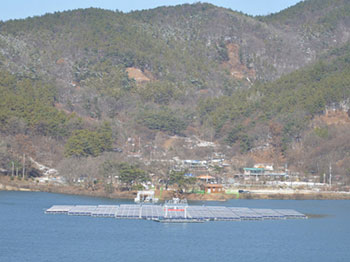Last year, Japan’s largest solar plant came online, a 70 MW Kyocera project with 290,000 solar panels that juts way out into Kagoshima Bay.
Now, Kyocera will build one that’s completely detached from the land, on a reservoir in Japan (Yamakura Dam). At 13.4 MW, it will have 50,000 modules covering 180,000 square meters of water – the largest floating solar project in the world so far. The company is also building two smaller ones totaling 2.9 MW.
In fact, floating solar projects are becoming popular with small installations in Britain (200 kW), Italy, and soon, in Singapore, India – which is installing them on canals and on reservoirs – and South Korea – which wants to install 4 GW of solar on 5% of its water surfaces.
Pilot floating project in South Korea:

There are lots of interesting benefits to floating solar over water:
- Water offers a stable surface, full exposure to the sun, and installation is cheaper;
- The entire PV plant can easily be moved, tracking and rotating with the sun;
- Water cools the modules, increasing energy production by 10%; during warm months, the ground heats up on land, reducing output;
- They reduce algae growth in the water, keeping it healthier for wildlife;
- They reduce evaporation, helping preserve water levels during warm months, which provides security for farmers;
- They are important for countries like Japan, where there’s little available land.
Because of all these advantages, South Korea’s Sunflower Solar Power Plant is expected to produce 22% more energy than a comparable ground-mounted PV project.
One thing we haven’t heard about is the potential negative affect on marine life from large projects that darken the surface water.
